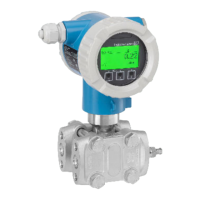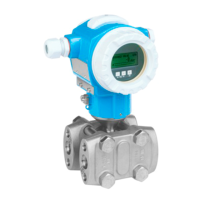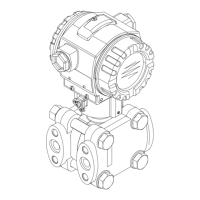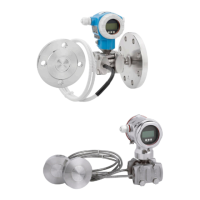Do you have a question about the Endress+Hauser Deltabar PMD75B HART and is the answer not in the manual?
Purpose of the Operating Instructions document.
Explains various symbols used in the manual for clarity.
Defines DANGER, WARNING, and CAUTION symbols for hazard levels.
Identifies symbols for electrical connections like ground.
Explains symbols used within graphics and diagrams.
Refers to safety instructions found on the device itself.
Provides a list of abbreviations used throughout the document.
Explains the method for calculating the turn down ratio.
Information on where to download available documents for the device.
Lists registered trademarks relevant to the product.
Specifies qualifications and authorization needed for personnel.
Defines the intended application of the Deltabar transmitter.
Safety precautions to be observed when working with the device.
Guidelines for safe operation and modifications to the device.
Statement on the product's adherence to safety standards and directives.
Requirement to observe the Functional Safety Manual for specific applications.
Explains warranty conditions related to IT security measures.
Details device features that enhance IT security.
Describes the overall product design and construction.
Details the measuring cell technology and its components.
Explains how flow is measured using the Deltabar and differential pressure sensor.
Procedures for checking the device upon receipt.
Lists all components included in the device's scope of delivery.
Methods to identify the measuring device and its specifications.
Provides the official address of the manufacturer.
Explains the information found on different types of device nameplates.
Guidelines for storing and transporting the device safely.
Specifies the recommended conditions for storing the device.
Precautions to take when moving the device to its installation location.
Requirements and conditions for installing the device.
Basic steps and precautions for installation.
Specific guidance for installing the device correctly.
Recommendations for routing and installing pressure piping.
Detailed instructions on how to mount the measuring device.
Specific mounting instructions for flow measurement applications.
Mounting instructions for level measurement in open and closed vessels.
Mounting instructions for pressure measurement applications.
Mounting instructions for differential pressure measurement.
Precautions and guidelines for using the device in oxygen applications.
Instructions on how to correctly seal for flange mounting.
Methods for mounting the device on walls or pipes.
Guidance for mounting the device with an optional manifold.
Steps for assembling and mounting the device with a separate housing.
How to rotate the display module for optimal viewing.
Instructions for properly closing the housing cover.
How to rotate the device housing for easier access.
A checklist of essential checks after completing the installation.
General conditions and requirements for electrical connections.
Instructions for proper potential equalization.
Step-by-step guide for connecting the measuring device electrically.
Specifies the required supply voltage range for the device.
Further details on recommended cable types and diameters.
Specifics for connecting the 4-20 mA HART communication.
Information on overvoltage protection for the device.
General wiring instructions and safety precautions.
Shows terminal assignments for single and dual compartment housings.
Details different types of cable entries and moisture prevention.
Information on various device plugs and their proper use.
Methods to ensure the specified degree of protection (IP rating).
Details IP ratings for various cable entry types.
Final checks after completing the electrical connection.
Lists the various ways to operate and configure the device.
Details the physical keys and DIP switches for operation.
Specific operational notes for HART communication.
Describes the structure and functionality of the device's operating menu.
How to access and use the device's local display for operation.
Describes the functions and features of the optional device display.
Step-by-step guide for operating the device wirelessly via Bluetooth.
Procedures for accessing the menu using operating tools like FieldCare.
Information about the HistoROM module for data storage.
Information about device description files (DD, DTM) and resources.
Details measured values assigned to HART variables.
Lists device variable codes and their corresponding measured values.
Details the supported system units for pressure measurements.
Steps to prepare the device before commissioning.
Describes the device's default configuration settings upon delivery.
Performing checks to ensure the device functions correctly before operation.
Instructions on how to power on the measuring device.
Procedures for connecting and configuring the device using FieldCare.
Connecting the device to FieldCare via the HART protocol.
Connecting via the service interface for FieldCare/DeviceCare.
Setting the device's communication address using software.
How to set the language for the device display and configuration tools.
Setting the language directly on the device's local display.
Setting the preferred language within the FieldCare software.
Core configuration steps for the measuring device.
Performing configuration using the device's physical keys.
Using the device's operating menu for commissioning.
Configuring the device to output pressure values via the current loop.
Step-by-step commissioning process guided by a wizard.
Setting and outputting measurement units using various operating tools.
Procedures for cleaning the pressure piping before device adjustment.
Detailed steps for commissioning flow measurement setups with manifolds.
Procedures for commissioning level measurement in open vessels.
Procedures for commissioning level measurement in closed vessels.
Commissioning for vessels with superimposed vapor.
How to access and use the simulation function for testing.
Methods to secure device settings against unauthorized changes.
Using the DIP switch for hardware-based locking.
Locking and unlocking the device's display operation.
Securing the device via software password.
How to check if the device settings are locked.
Procedures for reading current measured values from the device.
Adjusting the device for process conditions, including sensor calibration.
Steps for calibrating the pressure sensor to ensure accuracy.
General guidance for troubleshooting common device issues.
Troubleshooting common errors like device non-response or display issues.
Specific troubleshooting steps for errors encountered with SmartBlue.
Additional diagnostic tests to identify problem sources.
Defines how the current output behaves when errors occur.
How diagnostic messages are displayed on the local screen.
Explains the meaning of diagnostic messages and status signals.
Continues explanation of diagnostic messages, status signals, and event text.
How diagnostic events are presented in the operating tool.
Configuring how diagnostic information is displayed and prioritized.
Viewing queued diagnostic messages that are awaiting attention.
Accessing a list of pending diagnostic messages.
A comprehensive table detailing diagnostic events, their causes, and remedies.
Continues the comprehensive table of diagnostic events, causes, and remedies.
Managing and viewing the history of events recorded by the device.
Overview of chronological event messages.
Defining criteria to filter the event logbook.
Listing common information events logged by the device.
Procedure for resetting the device to factory default settings.
How to access detailed information about the device.
Information regarding past firmware versions.
Details about the original software version.
Essential tasks for maintaining the device's performance, including filter care and cleaning.
Instructions for keeping the pressure compensation filter clean.
Using flushing rings for diaphragm cleaning.
Guidelines for safely cleaning the device's exterior.
General principles, Ex-certified device repair, and safety limitations.
Explains the modular repair approach by Endress+Hauser.
Specific safety requirements for repairing Ex-certified devices.
Information on identifying and ordering spare parts.
Procedures for returning the device for calibration or other reasons.
Instructions for disposing of the device in compliance with regulations.
Lists various accessories available for the device, including connectors and mounting hardware.
Details different types of plug connectors for the device.
Information on weld-in adapters and related accessories.
Technical specifications related to the device's output signal.
Continuation of output specifications, including linearization and HART data.
Technical data regarding the operating environment.
Environmental data, temperature ranges, hazardous area information.
Storage temperature, altitude, climate, atmosphere, and degree of protection.
Vibration resistance and electromagnetic compatibility (EMC) data.
Technical data related to process temperature ranges.
Process temperature range with manifold, oxygen applications.
Process pressure ranges, burst pressure, and special application data.
Specific data for hydrogen applications.
Purpose of the Operating Instructions document.
Explains various symbols used in the manual for clarity.
Defines DANGER, WARNING, and CAUTION symbols for hazard levels.
Identifies symbols for electrical connections like ground.
Explains symbols used within graphics and diagrams.
Refers to safety instructions found on the device itself.
Provides a list of abbreviations used throughout the document.
Explains the method for calculating the turn down ratio.
Information on where to download available documents for the device.
Lists registered trademarks relevant to the product.
Specifies qualifications and authorization needed for personnel.
Defines the intended application of the Deltabar transmitter.
Safety precautions to be observed when working with the device.
Guidelines for safe operation and modifications to the device.
Statement on the product's adherence to safety standards and directives.
Requirement to observe the Functional Safety Manual for specific applications.
Explains warranty conditions related to IT security measures.
Details device features that enhance IT security.
Describes the overall product design and construction.
Details the measuring cell technology and its components.
Explains how flow is measured using the Deltabar and differential pressure sensor.
Procedures for checking the device upon receipt.
Lists all components included in the device's scope of delivery.
Methods to identify the measuring device and its specifications.
Provides the official address of the manufacturer.
Explains the information found on different types of device nameplates.
Guidelines for storing and transporting the device safely.
Specifies the recommended conditions for storing the device.
Precautions to take when moving the device to its installation location.
Requirements and conditions for installing the device.
Basic steps and precautions for installation.
Specific guidance for installing the device correctly.
Recommendations for routing and installing pressure piping.
Detailed instructions on how to mount the measuring device.
Specific mounting instructions for flow measurement applications.
Mounting instructions for level measurement in open and closed vessels.
Mounting instructions for pressure measurement applications.
Mounting instructions for differential pressure measurement.
Precautions and guidelines for using the device in oxygen applications.
Instructions on how to correctly seal for flange mounting.
Methods for mounting the device on walls or pipes.
Guidance for mounting the device with an optional manifold.
Steps for assembling and mounting the device with a separate housing.
How to rotate the display module for optimal viewing.
Instructions for properly closing the housing cover.
How to rotate the device housing for easier access.
A checklist of essential checks after completing the installation.
General conditions and requirements for electrical connections.
Instructions for proper potential equalization.
Step-by-step guide for connecting the measuring device electrically.
Specifies the required supply voltage range for the device.
Further details on recommended cable types and diameters.
Specifics for connecting the 4-20 mA HART communication.
Information on overvoltage protection for the device.
General wiring instructions and safety precautions.
Shows terminal assignments for single and dual compartment housings.
Details different types of cable entries and moisture prevention.
Information on various device plugs and their proper use.
Methods to ensure the specified degree of protection (IP rating).
Details IP ratings for various cable entry types.
Final checks after completing the electrical connection.
Lists the various ways to operate and configure the device.
Details the physical keys and DIP switches for operation.
Specific operational notes for HART communication.
Describes the structure and functionality of the device's operating menu.
How to access and use the device's local display for operation.
Describes the functions and features of the optional device display.
Step-by-step guide for operating the device wirelessly via Bluetooth.
Procedures for accessing the menu using operating tools like FieldCare.
Information about the HistoROM module for data storage.
Information about device description files (DD, DTM) and resources.
Details measured values assigned to HART variables.
Lists device variable codes and their corresponding measured values.
Details the supported system units for pressure measurements.
Steps to prepare the device before commissioning.
Describes the device's default configuration settings upon delivery.
Performing checks to ensure the device functions correctly before operation.
Instructions on how to power on the measuring device.
Procedures for connecting and configuring the device using FieldCare.
Connecting the device to FieldCare via the HART protocol.
Connecting via the service interface for FieldCare/DeviceCare.
Setting the device's communication address using software.
How to set the language for the device display and configuration tools.
Setting the language directly on the device's local display.
Setting the preferred language within the FieldCare software.
Core configuration steps for the measuring device.
Performing configuration using the device's physical keys.
Using the device's operating menu for commissioning.
Configuring the device to output pressure values via the current loop.
Step-by-step commissioning process guided by a wizard.
Setting and outputting measurement units using various operating tools.
Procedures for cleaning the pressure piping before device adjustment.
Detailed steps for commissioning flow measurement setups with manifolds.
Procedures for commissioning level measurement in open vessels.
Procedures for commissioning level measurement in closed vessels.
Commissioning for vessels with superimposed vapor.
How to access and use the simulation function for testing.
Methods to secure device settings against unauthorized changes.
Using the DIP switch for hardware-based locking.
Locking and unlocking the device's display operation.
Securing the device via software password.
How to check if the device settings are locked.
Procedures for reading current measured values from the device.
Adjusting the device for process conditions, including sensor calibration.
Steps for calibrating the pressure sensor to ensure accuracy.
General guidance for troubleshooting common device issues.
Troubleshooting common errors like device non-response or display issues.
Specific troubleshooting steps for errors encountered with SmartBlue.
Additional diagnostic tests to identify problem sources.
Defines how the current output behaves when errors occur.
How diagnostic messages are displayed on the local screen.
Explains the meaning of diagnostic messages and status signals.
Continues explanation of diagnostic messages, status signals, and event text.
How diagnostic events are presented in the operating tool.
Configuring how diagnostic information is displayed and prioritized.
Viewing queued diagnostic messages that are awaiting attention.
Accessing a list of pending diagnostic messages.
A comprehensive table detailing diagnostic events, their causes, and remedies.
Continues the comprehensive table of diagnostic events, causes, and remedies.
Managing and viewing the history of events recorded by the device.
Overview of chronological event messages.
Defining criteria to filter the event logbook.
Listing common information events logged by the device.
Procedure for resetting the device to factory default settings.
How to access detailed information about the device.
Information regarding past firmware versions.
Details about the original software version.
Essential tasks for maintaining the device's performance, including filter care and cleaning.
Instructions for keeping the pressure compensation filter clean.
Using flushing rings for diaphragm cleaning.
Guidelines for safely cleaning the device's exterior.
General principles, Ex-certified device repair, and safety limitations.
Explains the modular repair approach by Endress+Hauser.
Specific safety requirements for repairing Ex-certified devices.
Information on identifying and ordering spare parts.
Procedures for returning the device for calibration or other reasons.
Instructions for disposing of the device in compliance with regulations.
Lists various accessories available for the device, including connectors and mounting hardware.
Details different types of plug connectors for the device.
Information on weld-in adapters and related accessories.
Technical specifications related to the device's output signal.
Continuation of output specifications, including linearization and HART data.
Technical data regarding the operating environment.
Environmental data, temperature ranges, hazardous area information.
Storage temperature, altitude, climate, atmosphere, and degree of protection.
Vibration resistance and electromagnetic compatibility (EMC) data.
Technical data related to process temperature ranges.
Process temperature range with manifold, oxygen applications.
Process pressure ranges, burst pressure, and special application data.
Specific data for hydrogen applications.
| Device Type | Differential Pressure Transmitter |
|---|---|
| Communication Protocol | HART |
| Temperature Range (Ambient) | -40 to 85°C (-40 to 185°F) |
| Power Supply | 10.5 to 45 V DC |
| Accuracy | ±0.05% of span |
| Temperature Range (Process) | -40 to 125°C (-40 to 257°F) |
| Process Connection | Flanged, threaded, or sanitary connections |
| Output Signal | 4 to 20 mA HART |
| Housing Material | Aluminum or Stainless Steel |
| Sensor Material | Stainless Steel |
| Protection Rating | IP66/IP67 |
| Material | Stainless Steel |
| Certifications | ATEX, FM, CSA, IECEx, SIL, NEPSI |
| Long-term stability | ±0.1% of URL per year |











